As Finance Minister Muhammad Aurangzeb prepares to present the federal budget for 2025–26 on June 10, leading economists are urging the government to go beyond routine number-crunching and deliver a visionary financial plan. Their message is clear: this budget must balance defence needs with sustainable economic goals while positioning Pakistan in the evolving global industrial landscape.
In a series of public statements, the finance minister hinted at “bold measures” in the upcoming budget, promising a shift in the tax burden away from the salaried and documented sectors. He emphasized a greater reliance on digital transactions to expand the tax base and boost transparency. However, experts caution that success will require difficult trade-offs, strong political will, and an overarching economic strategy.
Budget Beyond Numbers: A Vision Test
Dr. Ali Hasanain of LUMS describes this year’s budget as “a test of vision.” With Pakistan facing tight fiscal constraints, including the IMF-mandated primary surplus target of 1.6% of GDP, and rising domestic and geopolitical pressures, the margin for error is minimal. He warns that attempts to fully restore the defence budget’s real value—down nearly $4.6 billion over five years—could wipe out gains made under economic reform programs and crowd out essential development and social spending.
Hasanain supports widening the tax net to include retailers, wholesalers, and petroleum sectors. However, he emphasizes that such reforms will test both the government’s political strength and administrative capacity. With trade wars heating up between global giants like the US and China, Pakistan must also prepare to adapt by investing in export infrastructure and logistics.
Shift to Investment-Led Growth
Economist Ammar H. Khan believes the budget should focus on macroeconomic stability and resist the temptation of artificial growth through state spending. He advocates transitioning towards an investment- and export-oriented growth model rather than one driven by imports and consumption.
Khan highlights a possible move towards tariff liberalisation as a key reform. Rationalizing excessive duties will help build a more competitive export sector and encourage formal business practices. He warns, however, that the current tax system discourages innovation and value addition by penalizing formal businesses and rewarding informal actors.
He stresses the need to promote savings and channel them into productive investments. “There’s no more pound of flesh left to extract,” Khan said, referring to the tax fatigue in the formal economy. He expects the budget to prioritise stabilization before pushing for broad-based growth.
People-Centered and Transparent Policy Needed
Economic journalist Afshan Subohi calls for a people-first approach. She argues the government must move away from regressive tax policies that burden the poor while rewarding inefficiencies in governance. The income tax exemption threshold, she suggests, should be raised to Rs1.3 million, and the middle class must be given relief.
Subohi advocates for reforms in the Public Sector Development Programme (PSDP), which often suffers from cuts during fiscal crunches. With private investment drying up, she says the state must step in—not only increasing development spending but ensuring it’s timely and transparent. She also recommends exploring alternative funding for security needs, including contributions from military-run commercial enterprises.
Moreover, Subohi stresses the need for shutting down redundant government departments, curbing luxury spending, and encouraging startups through incentives and accessible funding. Her emphasis is on long-term structural reforms, such as modernizing data systems and promoting provincial economic transparency.
Strategic Reforms and Defence Balancing
Dr. Aadil Nakhoda points out that the budget will likely involve lowering import tariffs—cutting peak tariffs from 20% to 15% and reducing tariff slabs—while increasing petroleum levies and possibly introducing carbon taxes. These shifts aim to broaden the tax base without overburdening consumers, while promoting environmental sustainability.
He notes that falling tariffs may reduce smuggling and encourage businesses to formally declare imports. On the other hand, these policies could hurt short-term revenue, requiring a careful balance. Nakhoda adds that defence spending will inevitably rise due to rising border tensions, though a shift toward technology-driven military spending could reshape the size and structure of the armed forces in the future.
A Balanced Budget Under IMF Scrutiny
Sajid Amin Javed, a macroeconomic analyst, expects a modest budget, constrained by ongoing IMF negotiations. Any relief for the salaried class, such as adjusting taxable income thresholds to Rs1.2 million, will depend on IMF approval. The government, he believes, is trying to avoid introducing new taxes and instead broaden the tax net by including agriculture and real estate sectors.
While he doesn’t foresee drastic tax rate hikes, Javed believes the government must embed sustainability in the fiscal framework. This includes shifting from revenue obsession to livelihood support and strategic investment in sectors that can yield long-term gains. He predicts a relatively “balanced” budget—less harsh than previous ones, but not as growth-friendly as desired.
He also forecasts that some developmental schemes in the PSDP may be shelved, with spending reprioritized in line with IMF recommendations. Defence, once again, will command a growing share of the budget, but without jeopardizing economic sustainability.
As Pakistan prepares to unveil its federal budget for 2025–26, the stakes could not be higher. The country stands at a critical juncture where fiscal discipline, political courage, and strategic clarity must converge. Whether the government can strike a balance between defence imperatives, economic stability, and inclusive growth will define not just the upcoming year—but the nation’s trajectory in a rapidly changing global order.















